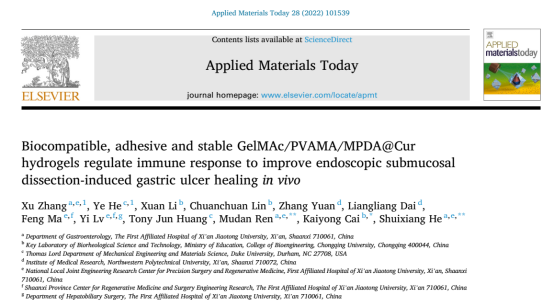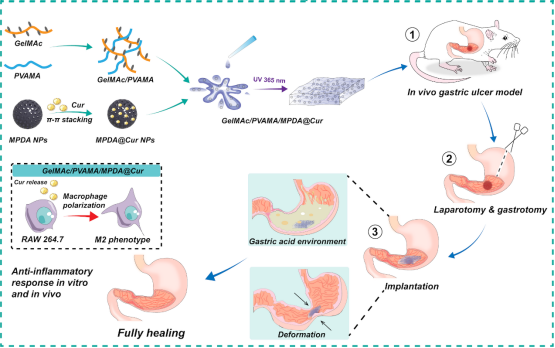Endoscopic submucosal dissection (ESD) and alternative ultra-minimally invasive endoscopic techniques have become the optimal therapeutic options for early digestive tract cancer, precancerous lesions, giant polyps and submucosal bulge lesions. However, ESD-induced "artificial ulcer" has become the most common complication affecting the patients' quality of life. In clinical practice, preventive measures are frequently adopted. Nevertheless, ulcer healing is delayed for over 8 weeks in a large proportion of patient, even leading to complications and threatening the patients’ lives. In recent years, the safety and long-term impact of PPI have captivated widespread attention. Therefore, there is an urgent need to explore a novel treatment with low toxicity, long-acting effect and high bioavailability, which is suitable for the whole digestive tract mucosal injury.

To resolve this clinical problem, the team led by He Shuixiang, Director of Department of Gastroenterology of the First Affiliated Hospital of Xi 'an Jiaotong University (XJTU) cooperated with the team of Professor Cai Kaiyong from Bioengineering College of Chongqing University to design a GelMAc/PVAMA hydrogel coated with curcumin polydopamine nanoparticles based on the special physiological environment of gastrointestinal tract and pathological microenvironment characteristics of wounds after ESD. Firstly, the hydrogel utilized large specific surface area of mesoporouspolydopamine nanoparticles (MPDA) and organized mesoporous structure to load curcumin to achieve high drug loading, thereby introducing gelatin methacrylol catechol (GelMAc) and poly (vinylalcohol)-methacrylate (PVAMA) substrates with strong adhesion, high biocompatibility and stable physical and chemical properties to form the gel. By adhering to the ulcer wound, hydrogel provides a protective barrier, isolates the stimulation of harmful factors, such as gastric acid, to the wound, and offers a favorable environment for wound healing. Topical accumulation of the protective curcumin surrounding the ulcer can significantly improve the drug bioavailability, prolong the action time, achieve the multi-mechanism, high-load, high-stability and long-lasting effect of the protective drug and accelerate rapid healing of artificial ulcer, providing novel therapeutic strategies and methods for wound healing, peptic ulcer and digestive tract mucosal injury after ESD. In vitro and in vivo experiments in this study proved that this hydrogel system can exert anti-inflammatory and anti-ROS effect and promote ulcer healing by regulating the polarization of macrophage M1/M2, which has promising application potential.

These findings are published as an article entitled “Biocompatible, adhesive and stable GelMAc/PVAMA/MPDA@Cur hydrogels regulate immune response to improve endoscopic submucosal dissection-induced gastric ulcer healing in vivo” in Applied Materials Today, an authoritative journal in the field of biomaterials worldwide. Doctoral student Zhang Xu from Department of Gastroenterology of our hospital, and doctoral student He Ye from Duke University in U.S. are the co-first authors. Professor He Shuixiang and Associate Professor Ren Mudan from our hospital and Professor Cai Kaiyong from Chongqing University are the co-corresponding authors. Our hospital is the first and corresponding affiliation of this article.
In recent years, under the guidance of Professor Lyu Yi, Professor He Shuixiang led the team to actively participate in the engineering medicine projects related to digestive tract tumors hosted by Research Center for Regenerative Medicine and Surgical Engineering of Shaanxi Province and Surgical Dreamworks, and made a series of breakthroughs in the field ofnovel technologies of engineering medicine for digestive tract diseases, successfully performed the first case of magnetic traction-assisted ESD for early gastric cancer in China, completed the world's first magnet squeezing surgery for anastomotic atresia recanalization after rectal cancer resection, and carried out the world's first magnet pre-labeled surgery for gastrointestinal lesions. The team was invited to deliver lectures and promote their achievements across China, making contributions to high-level development of our hospital.